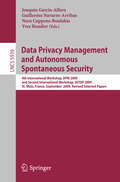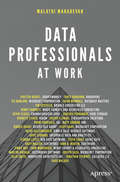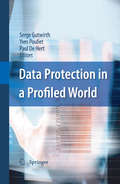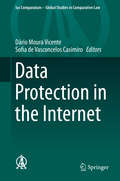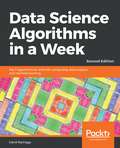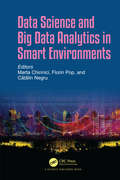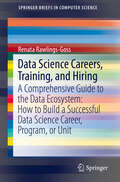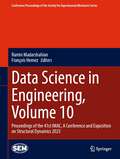- Table View
- List View
Data Mining Techniques for the Life Sciences (Methods in Molecular Biology #609)
by Oliviero Carugo and Frank EisenhaberMost life science researchers will agree that biology is not a truly theoretical branch of science. The hype around computational biology and bioinformatics beginning in the nineties of the 20th century was to be short lived (1, 2). When almost no value of practical importance such as the optimal dose of a drug or the three-dimensional structure of an orphan protein can be computed from fundamental principles, it is still more straightforward to determine them experimentally. Thus, experiments and observationsdogeneratetheoverwhelmingpartofinsightsintobiologyandmedicine. The extrapolation depth and the prediction power of the theoretical argument in life sciences still have a long way to go. Yet, two trends have qualitatively changed the way how biological research is done today. The number of researchers has dramatically grown and they, armed with the same protocols, have produced lots of similarly structured data. Finally, high-throu- put technologies such as DNA sequencing or array-based expression profiling have been around for just a decade. Nevertheless, with their high level of uniform data generation, they reach the threshold of totally describing a living organism at the biomolecular level for the first time in human history. Whereas getting exact data about living systems and the sophistication of experimental procedures have primarily absorbed the minds of researchers previously, the weight increasingly shifts to the problem of interpreting accumulated data in terms of biological function and bio- lecular mechanisms.
Data, Models and Analysis: The Highest Impact Articles in 'Atmosphere-Ocean'
by Guoqi Han, Hai Lin and Douw SteynThis volume contains the ten most cited articles that have appeared in the journal Atmosphere-Ocean since 1995. These articles cover a wide range of topics in meteorology, climatology and oceanography. Modelling work is represented in five papers, covering global climate model development; a cumulus parameterization scheme for global climate models; development of a regional forecast modelling system and parameterization of peatland hydraulic processes for climate models. Data rehabilitation and compilation in order to support trend analysis work on comprehensive precipitation and temperature data sets is presented in four papers. Field studies are represented by a paper on the circumpolar lead system. While the modelling studies are global in their application and applicability, the data analysis and field study papers cover environments that are specifically, but not uniquely, Canadian. This book will be of interest to researchers, students and professionals in the various sub-fields of meteorology, oceanography and climate science.
Data, Models and Analysis: The Highest Impact Articles in 'Atmosphere-Ocean'
by Guoqi Han Hai Lin Douw SteynThis volume contains the ten most cited articles that have appeared in the journal Atmosphere-Ocean since 1995. These articles cover a wide range of topics in meteorology, climatology and oceanography. Modelling work is represented in five papers, covering global climate model development; a cumulus parameterization scheme for global climate models; development of a regional forecast modelling system and parameterization of peatland hydraulic processes for climate models. Data rehabilitation and compilation in order to support trend analysis work on comprehensive precipitation and temperature data sets is presented in four papers. Field studies are represented by a paper on the circumpolar lead system. While the modelling studies are global in their application and applicability, the data analysis and field study papers cover environments that are specifically, but not uniquely, Canadian. This book will be of interest to researchers, students and professionals in the various sub-fields of meteorology, oceanography and climate science.
Data Monitoring Committees (DMCs): Past, Present, and Future
by Nand Kishore Rawat David KerrThis book provides an overview of Data Monitoring Committees(DMC) - what was done in the past, what is currently being done, and thoughts on improvements for the future. Previous works focused primarily on large cardiovascular studies (where DMCs originated more than 30 years ago) but updated references are needed that discuss smaller, more flexible studies in areas such as oncology. The authors have attended ~800 DMC meetings from ~200 distinct studies across all areas of clinical studies (oncology, rheumatology, rare diseases, cardiology, immunology, etc.) This wide range of expertise will be used, as well as the expertise that comes from working with virtually every large biotechnology and pharmaceutical company and CRO for DMC work. The reader of the book will know when DMCs are needed or helpful, how to form the DMC, how to work with external CROs and with sponsor teams and the DMC to create needed DMC outputs, how the DMC meetings are conducted, and - especially for DMC members - what are considerations within the Closed Session to review safety/efficacy outputs to assess risk/benefit to make appropriate recommendations that protect the patient safety and trial integrity. This is a practical hands-on book on how to decide if a DMC is necessary, how to form the DMC, how to expertly create the necessary materials for the DMC and have smooth running DMC meetings. There is no specialized training in school about how DMCs work - frequently people may have been in industry for many years without ever needing to work with a DMC. This book is the helpful reference for those new to these DMCs. The DMC work is critical to be correctly implemented as the impact of DMC activity on safeguarding the trial is so important.This book provides the following: Provides thorough instructions on the steps needed to form and implement a Data Monitoring Committee for clinical trial evaluation;Includes practical and hands-on information on DMC implementation;Discusses a wide range of clinical trial – by phase and therapeutic area.
Data Privacy Management and Autonomous Spontaneous Security: 4th International Workshop, DPM 2009 and Second International Workshop, SETOP 2009, St. Malo, France, September 24-25, 2009, Revised Selected Papers (Lecture Notes in Computer Science #5939)
by Joaquin Garcia-Alfaro Guillermo Navarro-Arribas Nora Cuppens-Boulahia Yves RoudierThis book constitutes the thoroughly refereed post-conference proceedings of the two international workshops DPM 2009, the 4th International Workshop on Data Privacy Management, and SETOP 2009, the Second International Workshop on Autonomous and Spontaneous Security, collocated with the ESORICS 2009 symposium in St. Malo, France, in September 2009. The 8 revised full papers for DPM 2009, selected from 23 submissions, presented together with two keynote lectures are accompanied by 9 revised full papers of SETOP 2009; all papers were carefully reviewed and selected for inclusion in the book. The DPM 2009 papers cover topics such as privacy in service oriented architectures, privacy-preserving mechanisms, crossmatching and indistinguishability techniques, privacy policies, and disclosure of information. The SETOP 2009 papers address all current issues within the sope of security policies, identification and privacy, as well as security mechanisms.
Data-processing in phytosociology: Report on the activities of the Working Group for data-processing in phytosociology of the International society for vegetation science, 1969–1978 (Advances in Vegetation Science #1)
by E. Van Der Maarel L. Orloci Sandro Pignatti(RANKIN) of equivocation information (1-:) and interaction information (M). The method is described in the present paper for I: and in a previous paper (Orloci, 1976) for M. The results presented in this paper suggest that for Species Rank order Information Percentage of total* species to be weighted according to their suitability to I· M I M r M characterize isolated groups of releves in a phytosociolo 5 7 54.15 2.31 17.97 0.82 gical table, the equivocation information may serve as a 9 5 49.86 23.19 16.55 8.22 3 3 9 47.79 0.56 15.86 0.20 suitable weight. The appropriate formulations are derived 6 4 8 36.18 1.18 12.01 0.42 4 5 3 24.36 59.34 8.09 21.03 and computed for some data from a salt marsh community. 8 6 4 24.25 39.04 8.05 13.84 10 7 I 21.96 71.17 7.29 25.23 7 8 2 18.67 69.01 6.20 24.46 9 10 18.40 6.11 10 6 5.64 16.31 1.87 5.78 References Total 301.00* 282.11 * 100.00 100.00 Feoli, E. 1973. An index for weighing characters in monothetic classifications. (Italian with English summary). Giorn. Bot. Ita!' 107: 263-268. Gower, J.e. 1967. A comparison of some methods of cluster is a monotone, increasing function of sample size if .. ).
Data Processing in Precise Time and Frequency Applications (Data and Knowledge in a Changing World)
by M. DesaintfuscienPhysical processes, involving atomic phenomena, allow more and more precise time and frequency measurements. This progress is not possible without convenient processing of the respective raw data. This book describes the data processing at various levels: design of the time and frequency references, characterization of the time and frequency references, and applications involving precise time and/or frequency references.
Data Production and Analysis in Population Genomics: Methods and Protocols (Methods in Molecular Biology #888)
by François Pompanon and Aurélie BoninPopulation genomics is a recently emerged discipline, which aims at understanding how evolutionary processes influence genetic variation across genomes. Today, in the era of cheaper next-generation sequencing, it is no longer as daunting to obtain whole genome data for any species of interest and population genomics is now conceivable in a wide range of fields, from medicine and pharmacology to ecology and evolutionary biology. However, because of the lack of reference genome and of enough a priori data on the polymorphism, population genomics analyses of populations will still involve higher constraints for researchers working on non-model organisms, as regards the choice of the genotyping/sequencing technique or that of the analysis methods. Therefore, Data Production and Analysis in Population Genomics purposely puts emphasis on protocols and methods that are applicable to species where genomic resources are still scarce. It is divided into three convenient sections, each one tackling one of the main challenges facing scientists setting up a population genomics study. The first section helps devising a sampling and/or experimental design suitable to address the biological question of interest. The second section addresses how to implement the best genotyping or sequencing method to obtain the required data given the time and cost constraints as well as the other genetic resources already available, Finally, the last section is about making the most of the (generally huge) dataset produced by using appropriate analysis methods in order to reach a biologically relevant conclusion. Written in the successful Methods in Molecular Biology™ series format, chapters include introductions to their respective topics, lists of the necessary materials and reagents, step-by-step, readily reproducible protocols, advice on methodology and implementation, and notes on troubleshooting and avoiding known pitfalls. Authoritative and easily accessible, Data Production and Analysis in Population Genomics serves a wide readership by providing guidelines to help choose and implement the best experimental or analytical strategy for a given purpose.
Data Professionals at Work
by Malathi MahadevanEnjoy reading interviews with more than two dozen data professionals to see a picture of what it’s like to work in the industry managing and analyzing data, helping you to know what it takes to move from your current expertise into one of the fastest growing areas of technology today. Data is the hottest word of the century, and data professionals are in high demand. You may already be a data professional such as a database administrator or business intelligence analyst. Or you may be one of the many people who want to work as a data professional, and are curious how to get there. Either way, this collection helps you understand how data professionals work, what makes them successful, and what they do to keep up.You’ll find interviews in this book with database administrators, database programmers, data architects, business intelligence professionals, and analytics professionals. Interviewees work across industry sectors ranging from healthcare and banking to finance and transportation and beyond. Each chapter illuminates a successful professional at the top of their game, who shares what helped them get to the top, and what skills and attitudes combine to make them successful in their respective fields.Interviewees in the book include: Mindy Curnutt, Julie Smith, Kenneth Fisher, Andy Leonard, Jes Borland, Kevin Feasel, Ginger Grant, Vicky Harp, Kendra Little, Jason Brimhall, Tim Costello, Andy Mallon, Steph Locke, Jonathan Stewart, Joseph Sack, John Q. Martin, John Morehouse, Kathi Kellenberger, Argenis Fernandez, Kirsten Benzel, Tracy Boggiano, Dave Walden, Matt Gordon, Jimmy May, Drew Furgiuele, Marlon Ribunal, and Joseph Fleming. All of them have been successful in their careers, and share their perspectives on working and succeeding in the field as data and database professionals. What You'll LearnStand out as an outstanding professional in your area of data work by developing the right set of skills and attitudes that lead to successAvoid common mistakes and pitfalls, and recover from operational failures and bad technology decisionsUnderstand current trends and best practices, and stay out in front as the field evolvesBreak into working with data through database administration, business intelligence, or any of the other career paths represented in this bookManage stress and develop a healthy work-life balance no matter which career path you decide uponChoose a suitable path for yourself from among the different career paths in working with dataWho This Book Is ForDatabase administrators and developers, database and business intelligence architects, consultants, and analytic professionals, as well as those intent on moving into one of those career paths. Aspiring data professionals and those in related technical fields who want to make a move toward managing or analyzing data on a full-time basis will find the book useful. Existing data professionals who want to be outstanding and successful at what they do will also appreciate the book's advice and guidance.
Data Protection in a Profiled World
by Serge Gutwirth Yves Poullet Paul De HertOne of the most challenging issues facing our current information society is the accelerating accumulation of data trails in transactional and communication systems, which may be used not only to profile the behaviour of individuals for commercial, marketing and law enforcement purposes, but also to locate and follow things and actions. Data mining, convergence, interoperability, ever- increasing computer capacities and the extreme miniaturisation of the hardware are all elements which contribute to a major contemporary challenge: the profiled world. This interdisciplinary volume offers twenty contributions that delve deeper into some of the complex but urgent questions that this profiled world addresses to data protection and privacy. The chapters of this volume were all presented at the second Conference on Privacy and Data Protection (CPDP2009) held in Brussels in January 2009 (www.cpdpconferences.org). The yearly CPDP conferences aim to become Europe’s most important meeting where academics, practitioners, policy-makers and activists come together to exchange ideas and discuss emerging issues in information technology, privacy and data protection and law. This volume reflects the richness of the conference, containing chapters by leading lawyers, policymakers, computer, technology assessment and social scientists. The chapters cover generic themes such as the evolution of a new generation of data protection laws and the constitutionalisation of data protection and more specific issues like security breaches, unsolicited adjustments, social networks, surveillance and electronic voting. This book not only offers a very close and timely look on the state of data protection and privacy in our profiled world, but it also explores and invents ways to make sure this world remains a world we want to live in.
Data Protection in the Internet (Ius Comparatum - Global Studies in Comparative Law #38)
by Dário Moura Vicente Sofia de Vasconcelos CasimiroThis book identifies and explains the different national approaches to data protection – the legal regulation of the collection, storage, transmission and use of information concerning identified or identifiable individuals – and determines the extent to which they could be harmonised in the foreseeable future. In recent years, data protection has become a major concern in many countries, as well as at supranational and international levels. In fact, the emergence of computing technologies that allow lower-cost processing of increasing amounts of information, associated with the advent and exponential use of the Internet and other communication networks and the widespread liberalization of the trans-border flow of information have enabled the large-scale collection and processing of personal data, not only for scientific or commercial uses, but also for political uses. A growing number of governmental and private organizations now possess and use data processing in order to determine, predict and influence individual behavior in all fields of human activity. This inevitably entails new risks, from the perspective of individual privacy, but also other fundamental rights, such as the right not to be discriminated against, fair competition between commercial enterprises and the proper functioning of democratic institutions. These phenomena have not been ignored from a legal point of view: at the national, supranational and international levels, an increasing number of regulatory instruments – including the European Union’s General Data Protection Regulation applicable as of 25 May 2018 – have been adopted with the purpose of preventing personal data misuse. Nevertheless, distinct national approaches still prevail in this domain, notably those that separate the comprehensive and detailed protective rules adopted in Europe since the 1995 Directive on the processing of personal data from the more fragmented and liberal attitude of American courts and legislators in this respect. In a globalized world, in which personal data can instantly circulate and be used simultaneously in communications networks that are ubiquitous by nature, these different national and regional approaches are a major source of legal conflict.
Data Science Algorithms in a Week, Second Edition: Top 7 Algorithms For Scientific Computing, Data Analysis, And Machine Learning, 2nd Edition
by Dávid NatinggaChoosing the right algorithm is often a key differentiator in the success or failure of a data model and its optimal performance. This book introduces you to 7 key machine learning algorithms which you can easily grasp within a week and includes exercises that will help you learn different aspects of machine learning without any hassle.
Data Science and Big Data Analytics in Smart Environments
by Marta Chinnici Florin Pop Catalin NegruMost applications generate large datasets, like social networking and social influence programs, smart cities applications, smart house environments, Cloud applications, public web sites, scientific experiments and simulations, data warehouse, monitoring platforms, and e-government services. Data grows rapidly, since applications produce continuously increasing volumes of both unstructured and structured data. Large-scale interconnected systems aim to aggregate and efficiently exploit the power of widely distributed resources. In this context, major solutions for scalability, mobility, reliability, fault tolerance and security are required to achieve high performance and to create a smart environment. The impact on data processing, transfer and storage is the need to re-evaluate the approaches and solutions to better answer the user needs. A variety of solutions for specific applications and platforms exist so a thorough and systematic analysis of existing solutions for data science, data analytics, methods and algorithms used in Big Data processing and storage environments is significant in designing and implementing a smart environment.Fundamental issues pertaining to smart environments (smart cities, ambient assisted leaving, smart houses, green houses, cyber physical systems, etc.) are reviewed. Most of the current efforts still do not adequately address the heterogeneity of different distributed systems, the interoperability between them, and the systems resilience. This book will primarily encompass practical approaches that promote research in all aspects of data processing, data analytics, data processing in different type of systems: Cluster Computing, Grid Computing, Peer-to-Peer, Cloud/Edge/Fog Computing, all involving elements of heterogeneity, having a large variety of tools and software to manage them. The main role of resource management techniques in this domain is to create the suitable frameworks for development of applications and deployment in smart environments, with respect to high performance. The book focuses on topics covering algorithms, architectures, management models, high performance computing techniques and large-scale distributed systems.
Data Science and Big Data Analytics in Smart Environments
by Marta Chinnici; Florin Pop; Cătălin NegruMost applications generate large datasets, like social networking and social influence programs, smart cities applications, smart house environments, Cloud applications, public web sites, scientific experiments and simulations, data warehouse, monitoring platforms, and e-government services. Data grows rapidly, since applications produce continuously increasing volumes of both unstructured and structured data. Large-scale interconnected systems aim to aggregate and efficiently exploit the power of widely distributed resources. In this context, major solutions for scalability, mobility, reliability, fault tolerance and security are required to achieve high performance and to create a smart environment. The impact on data processing, transfer and storage is the need to re-evaluate the approaches and solutions to better answer the user needs. A variety of solutions for specific applications and platforms exist so a thorough and systematic analysis of existing solutions for data science, data analytics, methods and algorithms used in Big Data processing and storage environments is significant in designing and implementing a smart environment.Fundamental issues pertaining to smart environments (smart cities, ambient assisted leaving, smart houses, green houses, cyber physical systems, etc.) are reviewed. Most of the current efforts still do not adequately address the heterogeneity of different distributed systems, the interoperability between them, and the systems resilience. This book will primarily encompass practical approaches that promote research in all aspects of data processing, data analytics, data processing in different type of systems: Cluster Computing, Grid Computing, Peer-to-Peer, Cloud/Edge/Fog Computing, all involving elements of heterogeneity, having a large variety of tools and software to manage them. The main role of resource management techniques in this domain is to create the suitable frameworks for development of applications and deployment in smart environments, with respect to high performance. The book focuses on topics covering algorithms, architectures, management models, high performance computing techniques and large-scale distributed systems.
Data Science and SDGs: Challenges, Opportunities and Realities
by Bikas Kumar Sinha Md. Nurul Haque MollahThe book presents contributions on statistical models and methods applied, for both data science and SDGs, in one place. Measuring and controlling data of SDGs, data driven measurement of progress needs to be distributed to stakeholders. In this situation, the techniques used in data science, specially, in the big data analytics, play an important role rather than the traditional data gathering and manipulation techniques. This book fills this space through its twenty contributions. The contributions have been selected from those presented during the 7th International Conference on Data Science and Sustainable Development Goals organized by the Department of Statistics, University of Rajshahi, Bangladesh; and cover topics mainly on SDGs, bioinformatics, public health, medical informatics, environmental statistics, data science and machine learning. The contents of the volume would be useful to policymakers, researchers, government entities, civil society, and nonprofit organizations for monitoring and accelerating the progress of SDGs.
Data Science Careers, Training, and Hiring: A Comprehensive Guide to the Data Ecosystem: How to Build a Successful Data Science Career, Program, or Unit (SpringerBriefs in Computer Science)
by Renata Rawlings-GossThis book is an information packed overview of how to structure a data science career, a data science degree program, and how to hire a data science team, including resources and insights from the authors experience with national and international large-scale data projects as well as industry, academic and government partnerships, education, and workforce. Outlined here are tips and insights into navigating the data ecosystem as it currently stands, including career skills, current training programs, as well as practical hiring help and resources. Also, threaded through the book is the outline of a data ecosystem, as it could ultimately emerge, and how career seekers, training programs, and hiring managers can steer their careers, degree programs, and organizations to align with the broader future of data science. Instead of riding the current wave, the author ultimately seeks to help professionals, programs, and organizations alike prepare a sustainable plan for growth in this ever-changing world of data. The book is divided into three sections, the first “Building Data Careers”, is from the perspective of a potential career seeker interested in a career in data, the second “Building Data Programs” is from the perspective of a newly forming data science degree or training program, and the third “Building Data Talent and Workforce” is from the perspective of a Data and Analytics Hiring Manager. Each is a detailed introduction to the topic with practical steps and professional recommendations. The reason for presenting the book from different points of view is that, in the fast-paced data landscape, it is helpful to each group to more thoroughly understand the desires and challenges of the other. It will, for example, help the career seekers to understand best practices for hiring managers to better position themselves for jobs. It will be invaluable for data training programs to gain the perspective of career seekers, who they want to help and attract as students. Also, hiring managers will not only need data talent to hire, but workforce pipelines that can only come from partnerships with universities, data training programs, and educational experts. The interplay gives a broader perspective from which to build.
Data Science for Engineers
by Raghunathan Rengaswamy Resmi SureshWith tremendous improvement in computational power and availability of rich data, almost all engineering disciplines use data science at some level. This textbook presents material on data science comprehensively, and in a structured manner. It provides conceptual understanding of the fields of data science, machine learning, and artificial intelligence, with enough level of mathematical details necessary for the readers. This will help readers understand major thematic ideas in data science, machine learning and artificial intelligence, and implement first-level data science solutions to practical engineering problems. The book- Provides a systematic approach for understanding data science techniques Explain why machine learning techniques are able to cross-cut several disciplines. Covers topics including statistics, linear algebra and optimization from a data science perspective. Provides multiple examples to explain the underlying ideas in machine learning algorithms Describes several contemporary machine learning algorithms The textbook is primarily written for undergraduate and senior undergraduate students in different engineering disciplines including chemical engineering, mechanical engineering, electrical engineering, electronics and communications engineering for courses on data science, machine learning and artificial intelligence.
Data Science for Engineers
by Raghunathan Rengaswamy Resmi SureshWith tremendous improvement in computational power and availability of rich data, almost all engineering disciplines use data science at some level. This textbook presents material on data science comprehensively, and in a structured manner. It provides conceptual understanding of the fields of data science, machine learning, and artificial intelligence, with enough level of mathematical details necessary for the readers. This will help readers understand major thematic ideas in data science, machine learning and artificial intelligence, and implement first-level data science solutions to practical engineering problems. The book- Provides a systematic approach for understanding data science techniques Explain why machine learning techniques are able to cross-cut several disciplines. Covers topics including statistics, linear algebra and optimization from a data science perspective. Provides multiple examples to explain the underlying ideas in machine learning algorithms Describes several contemporary machine learning algorithms The textbook is primarily written for undergraduate and senior undergraduate students in different engineering disciplines including chemical engineering, mechanical engineering, electrical engineering, electronics and communications engineering for courses on data science, machine learning and artificial intelligence.
Data Science for Nano Image Analysis (International Series in Operations Research & Management Science #308)
by Chiwoo Park Yu DingThis book combines two distinctive topics: data science/image analysis and materials science. The purpose of this book is to show what type of nano material problems can be better solved by which set of data science methods. The majority of material science research is thus far carried out by domain-specific experts in material engineering, chemistry/chemical engineering, and mechanical & aerospace engineering. The book could benefit materials scientists and manufacturing engineers who were not exposed to systematic data science training while in schools, or data scientists in computer science or statistics disciplines who want to work on material image problems or contribute to materials discovery and optimization.This book provides in-depth discussions of how data science and operations research methods can help and improve nano image analysis, automating the otherwise manual and time-consuming operations for material engineering and enhancing decision making for nano material exploration. A broad set of data science methods are covered, including the representations of images, shape analysis, image pattern analysis, and analysis of streaming images, change points detection, graphical methods, and real-time dynamic modeling and object tracking. The data science methods are described in the context of nano image applications, with specific material science case studies.
Data Science for Neuroimaging: An Introduction
by Ariel Rokem Tal YarkoniData science methods and tools—including programming, data management, visualization, and machine learning—and their application to neuroimaging researchAs neuroimaging turns toward data-intensive discovery, researchers in the field must learn to access, manage, and analyze datasets at unprecedented scales. Concerns about reproducibility and increased rigor in reporting of scientific results also demand higher standards of computational practice. This book offers neuroimaging researchers an introduction to data science, presenting methods, tools, and approaches that facilitate automated, reproducible, and scalable analysis and understanding of data. Through guided, hands-on explorations of openly available neuroimaging datasets, the book explains such elements of data science as programming, data management, visualization, and machine learning, and describes their application to neuroimaging. Readers will come away with broadly relevant data science skills that they can easily translate to their own questions.• Fills the need for an authoritative resource on data science for neuroimaging researchers• Strong emphasis on programming• Provides extensive code examples written in the Python programming language• Draws on openly available neuroimaging datasets for examples• Written entirely in the Jupyter notebook format, so the code examples can be executed, modified, and re-executed as part of the learning process
Data Science for Social Good: Philanthropy and Social Impact in a Complex World (SpringerBriefs in Complexity)
by Massimo Lapucci Ciro CattutoThis book is a collection of reflections by thought leaders at first-mover organizations in the exploding field of "Data Science for Social Good", meant as the application of knowledge from computer science, complex systems and computational social science to challenges such as humanitarian response, public health, sustainable development. The book provides both an overview of scientific approaches to social impact – identifying a social need, targeting an intervention, measuring impact – and the complementary perspective of funders and philanthropies that are pushing forward this new sector. This book will appeal to students and researchers in the rapidly growing field of data science for social impact, to data scientists at companies whose data could be used to generate more public value, and to decision makers at nonprofits, foundations, and agencies that are designing their own agenda around data.
Data Science in Engineering, Volume 10: Proceedings of the 41st IMAC, A Conference and Exposition on Structural Dynamics 2023 (Conference Proceedings of the Society for Experimental Mechanics Series)
by Ramin Madarshahian François HemezData Science in Engineering, Volume 10: Proceedings of the 41st IMAC, A Conference and Exposition on Structural Dynamics, 2023, the tenth volume of ten from the Conference brings together contributions to this important area of research and engineering. The collection presents early findings and case studies on fundamental and applied aspects of Data Science in Engineering, including papers on:Novel Data-driven Analysis MethodsDeep Learning Gaussian Process AnalysisReal-time Video-based AnalysisApplications to Nonlinear Dynamics and Damage DetectionHigh-rate Structural Monitoring and Prognostics
Data Science, Learning by Latent Structures, and Knowledge Discovery (Studies in Classification, Data Analysis, and Knowledge Organization)
by Berthold Lausen Sabine Krolak-Schwerdt Matthias BöhmerThis volume comprises papers dedicated to data science and the extraction of knowledge from many types of data: structural, quantitative, or statistical approaches for the analysis of data; advances in classification, clustering and pattern recognition methods; strategies for modeling complex data and mining large data sets; applications of advanced methods in specific domains of practice. The contributions offer interesting applications to various disciplines such as psychology, biology, medical and health sciences; economics, marketing, banking and finance; engineering; geography and geology; archeology, sociology, educational sciences, linguistics and musicology; library science. The book contains the selected and peer-reviewed papers presented during the European Conference on Data Analysis (ECDA 2013) which was jointly held by the German Classification Society (GfKl) and the French-speaking Classification Society (SFC) in July 2013 at the University of Luxembourg.
Data Science with Python: Combine Python With Machine Learning Principles To Discover Hidden Patterns In Raw Data
by Rohan Chopra Aaron England Mohamed Noordeen AlaudeenCombine Python with machine learning principles to discover hidden patterns in raw data
Data Science with R for Psychologists and Healthcare Professionals
by Christian RyanThis introduction to R for students of psychology and health sciences aims to fast-track the reader through some of the most difficult aspects of learning to do data analysis and statistics. It demonstrates the benefits for reproducibility and reliability of using a programming language over commercial software packages such as SPSS. The early chapters build at a gentle pace, to give the reader confidence in moving from a point-and-click software environment, to the more robust and reliable world of statistical coding. This is a thoroughly modern and up-to-date approach using RStudio and the tidyverse. A range of R packages relevant to psychological research are discussed in detail. A great deal of research in the health sciences concerns questionnaire data, which may require recoding, aggregation and transformation before quantitative techniques and statistical analysis can be applied. R offers many useful and transparent functions to process data and check psychometric properties. These are illustrated in detail, along with a wide range of tools R affords for data visualisation. Many introductory statistics books for the health sciences rely on toy examples - in contrast, this book benefits from utilising open datasets from published psychological studies, to both motivate and demonstrate the transition from data manipulation and analysis to published report. R Markdown is becoming the preferred method for communicating in the open science community. This book also covers the detail of how to integrate the use of R Markdown documents into the research workflow and how to use these in preparing manuscripts for publication, adhering to the latest APA style guidelines.



